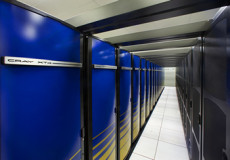VisIt Supported on Cray Systems
May 26, 2009
Scientists computing on NERSC's Cray XT4 system, called Franklin, can have it all. Now that VisIt, one of the most popular frameworks for scientific visualization, is available on Franklin, users can run their simulations on the machine and visualize the output there too.
“VisIt is a very useful tool for interpreting scientific data; researchers can use this to explore data from a variety of perspectives,” says Gunther Weber of the CRD Visualization Group and the NERSC Analytics Team.
He notes that the tool can be used to visualize scalar and vector fields defined on two- and three-dimensional structured and unstructured meshes. It was also designed to run on a variety of platforms, as well as handle datasets ranging in size from terascale to kilobyte.
“One of the biggest benefits of using VisIt on Franklin is that I don’t have to transfer datasets from Franklin’s scratch file system to DaVinci, ” says Mike Barad, of Stanford University’s Environmental Fluid Mechanics Laboratory. “This saves me time because I don’t have to worry about moving my data from one machine to another, and it’s just one less thing to think about.”
DaVinci is a NERSC system dedicated to visualizations.
According to Weber, this new capability can also save users time because the Franklin system contains about 38,640 compute cores. This means that users with complex and massive datasets can spread their visualization projects across multiple processors and generate results much faster than they would on a local workstation with approximately four processors or a small cluster with tens of processors. Users can set up the parameters for their visualizations on a local workstation and then queue the project to run on Franklin.
“It is also a lot less disruptive to other users if you run a parallel visualization application on 40 cores of a machine with tens of thousands of processors, rather than if run at the same level of concurrency on a machine with only 60 processors,” says Weber.
VisIt was initially developed by the Department of Energy (DOE) Advanced Simulation and Computing Initiative (ASCI) to visualize and analyze the results of terascale simulations. More recently, the Visualization and Analytics Center for Enabling Technology, which is part of DOE's Scientific Discovery Through Advanced Computing (SciDAC) program, has extended its capability for use on today's largest scientific datasets and on today's largest computational platforms. The result is a capability for gaining scientific knowledge and understanding of the large datasets generated by open scientific computing programs. Many organizations now contribute to its development, including Lawrence Berkeley, Lawrence Livermore, and Oak Ridge National Laboratories, among many others.
About NERSC and Berkeley Lab
The National Energy Research Scientific Computing Center (NERSC) is a U.S. Department of Energy Office of Science User Facility that serves as the primary high performance computing center for scientific research sponsored by the Office of Science. Located at Lawrence Berkeley National Laboratory, NERSC serves almost 10,000 scientists at national laboratories and universities researching a wide range of problems in climate, fusion energy, materials science, physics, chemistry, computational biology, and other disciplines. Berkeley Lab is a DOE national laboratory located in Berkeley, California. It conducts unclassified scientific research and is managed by the University of California for the U.S. Department of Energy. »Learn more about computing sciences at Berkeley Lab.








